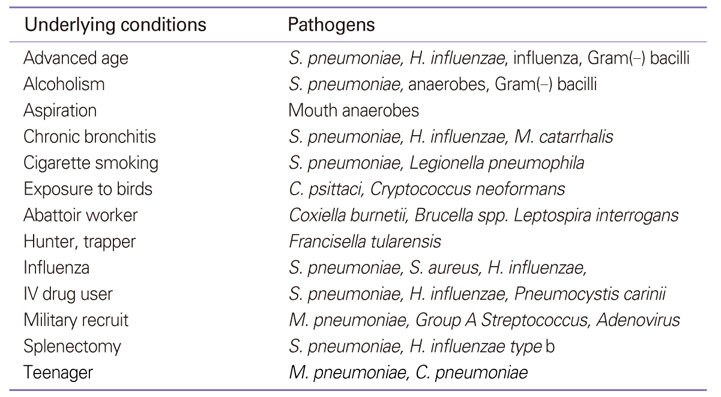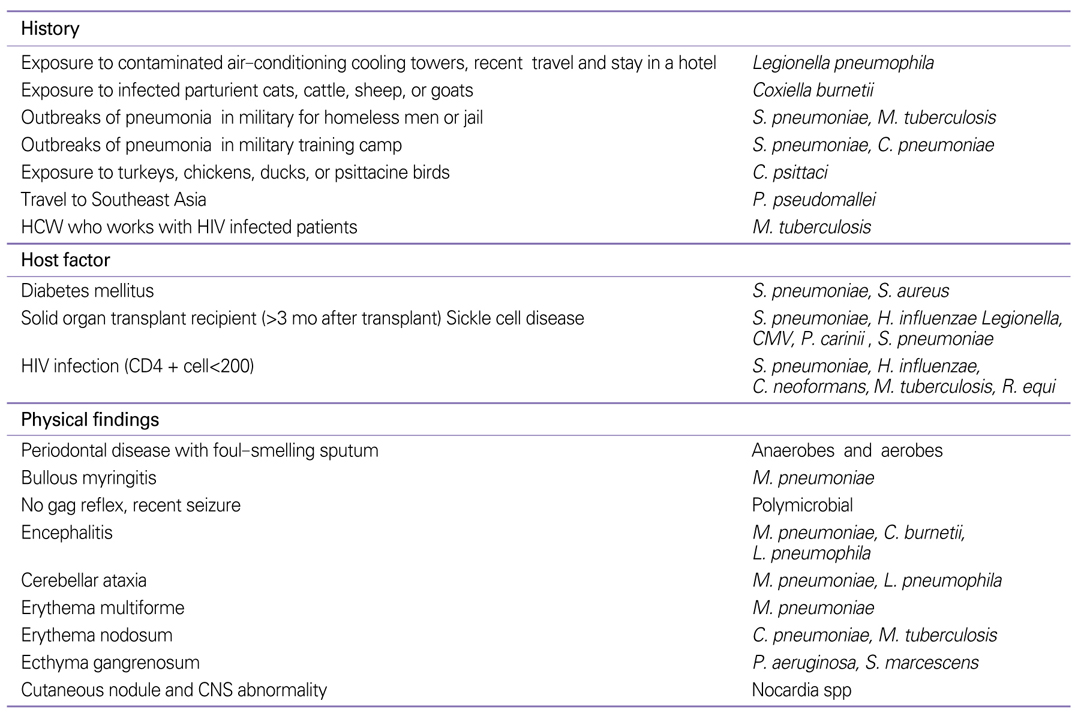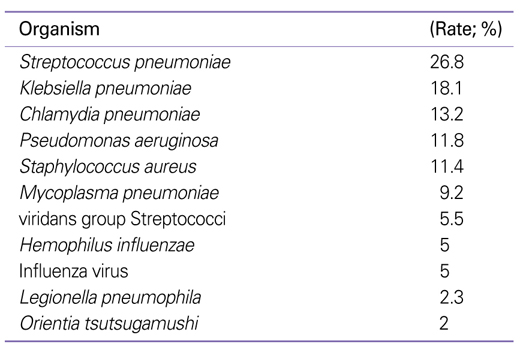 |
 |
- Search
| J Korean Med Assoc > Volume 50(10); 2007 > Article |
Abstract
Pneumonia is the 12th leading cause of death among Korean population in 2005. In spite of sophisticated diagnostic assessments and treatment techniques, the management of the pneumonia is still challenging. Furthermore, the emergence of antibiotic-resistant microorganisms poses difficulties to the selection of optimal antimicrobial agents. The empirical antibiotic regimen for the community-acquired pneumonia is based on the epidemiologic characteristics of the causative pathogens, for example, Streptococcus pneumoniae, Staphylococcus aureus after influenza outbreak, Klebsiella pneumoniae, Moraxella catarrhalis, and Pseudomonas aeruginosa in patients with chronic obstructive lung diseases. The most important and frequent etiologic organism is S. pneumonia according to a prospective multicenter study by investigators including the author, followed by K. pneumoniae, Chlamydia pneumoniae, P. aeruginosa, S. aureus, and M. pneumoniae in decreasing order. Still we need a nation-wide surveillance system of the community-acquired pneumonia because we are not certain about the etiology in almost half the cases of community-acquired pneumonia.
References
1. Woo JH. Pneumonia and Clinical Understanding 1998;Ulsan University of Ulsan Press.
2. Chang J. Community acquired pneumonia. J Korean Med Assoc 1997;40:533-547.
3. Woo JH, Kang JM, Kim YS, Shin WS, Yoo JH, Choi JH, Kim YR, Cheong HJ, Uh ST, Park CS, Chung MH, Chung KS, Lee CJ, Ryu J. A prospective multicenter study of community acquired pneumonia in adults with emphasis in bacterial etiology. Korean J Infect Dis 2001;33:1-7.
4. Kim JH, Kwak YH, Na BK, Lee JY, Shin GC, Jung HS, Hong JY, Oh MD, Cheong HJ, Kim MJ, Pai HJ, Kim YR, Shin WS, Kang JM, Woo JH, Uh ST, Lee HJ. Viral Etiology of Community acquired pneumonia in Korean adults. Korean J Infect Dis 2001;33:8-14.
5. Han YC, Woo JH. Diagnosis and treatment of bacterial pneumonia in Korea. Respirology 1996;115:1.
6. Woo JH, Lee JS, Kwon KH, Kim KH, Choi CH, Park CS, Lee WG, Choi TY. Etiologies of Bacterial Pneumonia with Implications for Therapy. Tuberc Respir Dis 1995;42:67-75.
7. Chung JW, Woo JH. Understanding of Severe Acute Respiratory syndrome (Review). Korean J Med 2003;65:154-159.
8. Bartlett JG, Mundy LM. Community-acquired pneumonia. N Engl J Med 1995;333:1618-1624.
9. File TM. Community-acquired pneumonia. Lancet 2003;362:1991-2001.
10. Liam CK, Pang YK, Poosparajah S, Chua KT. Community-acquired pneumonia: an Asia Pacific perspective. Respirology 2007;12:162-164.
11. Farr BM, Kaiser DL, Harrison BD, Connolly CK. British Thoracic Society Pneumonia Research Subcommittee. Prediction of microbial aetiology at admission to hospital for pneumonia from the presenting clinical features. Thorax 1989;44:103-115.
12. Mandell LA. Epidemiology and etiology of community-acquired pneumonia. Infect Dis Clin North Am 2004;18:761-776.
13. British Thoracic Society Research Committee. Community-acquired pneumonia in adults in British hospitals in 1982-1983: a survey of aetiology, mortality, prognostic factors, and outcome. Q J Med 1987;62:195-220.
14. Neill AM, Martin IR, Weir R, Anderson R, Chereshsky A, Epton MJ, Jackson R, Schousboe M, Frampton C, Hutton S, Chambers ST, Town GI. Community acquired pneumonia: etiology and usefulness of severity criteria on admission. Thorax 1996;51:101-106.
15. Almirall J, Bolibar I, Vidal J, Sauca G, Coll P, Niklasson B, Bartolome M, Balanzo X. Epidemiology of community-acquired pneumon ia in adults: a population-based study. Eur Respir J 2000;15:757-763.
16. Oh HK, Seo JY, Kim DK, Choi JE, Mo EK, Park MJ, Lee MG, Hyun IG, Jung KS. Clinical Characteristics and Prognostic Factors of Severe Community acquired pneumonia. Tuberc Respir Dis 1997;44:1072-1082.
17. Torres A, Serra-Batlles J, Ferrer A, Jimenez P, Celis R, Cobo E, Rodriguez-Roisin R. Severe community-acquired pneumonia. Epidemiology and prognostic factors. Am Rev Respir Dis 1991;144:312-318.
18. El Solh AA, Sikka P, Ramadan F, Davies J. Etiology of severe pneumonia in the very elderly. Am J Respir Crit Care Med 2001;163:645-651.
19. Blasi F. Atypical pathogens and respiratory tract infections. Eur Respir J 2004;24:171-181.
20. Bartlett JG. Diagnostic test for etiologic agents of community-acquired pneumonia. Infect Dis Clin North Am 2004;18:809-827.
21. Mandell LA, Wunderink RG, Anzueto A, Bartlett JG, Campbell GD, Dean NC, Dowell SF, File TM, Musher DM, Niederman MS, Torres A, Whitney CG. Infectious Diseases Society of America/American Thoracic Society Consensus Guidelines on the Management of Community-Acquired Pneumonia in Adults. Clin Infect Dis 2007;44:S27-S72.
22. Lee MS, Woo JH, Kim BN, Kim EO, Kim YS, Ryu JS, Choi CH, Kim JW, Jin SY, Lee DH. A Case of Streptococcus Pneumoniae Infection with AIDS-An Autopsy Report-Korean. J Infect Dis 1996;28:269-275.
23. Lee JM, Kim DK, Choi JE, Kim DH, Mo EK, Park MJ, Lee MG, Hyun IG, Jung KS. Use of protected specimen brush for the diagnosis of pulmonary infection. Korean J Med 1997;53:147-152.
24. Kim BN, Bae IG, Kim MN, Park SJ, Woo JH, Ryu J, Kim YS. Risk Factors for Penicillin Resistance and Mortality in Korean Adults with Streptococcus pneumoniae Bacteremia. Eur J Clin Microbiol Infect Dis 2002;21:35-42.
- TOOLS
-
METRICS

-
- 1 Crossref
- Scopus
- 1,235 View
- 5 Download
-
Related articles in
J Korean Med Assoc -
Epidemiology and pathogenesis of scabies2023 December;66(12)
Community Acquired Pheumonia1997 May;40(5)
Epidemiology and Risk Factors of Breast Cancer2003 June;46(6)
Community Acquired Pneumonia2004 November;47(11)
Definition, Epidemiology and Pathogenesis of Chronic Obstructive Pulmonary Disease2006 April;49(4)









